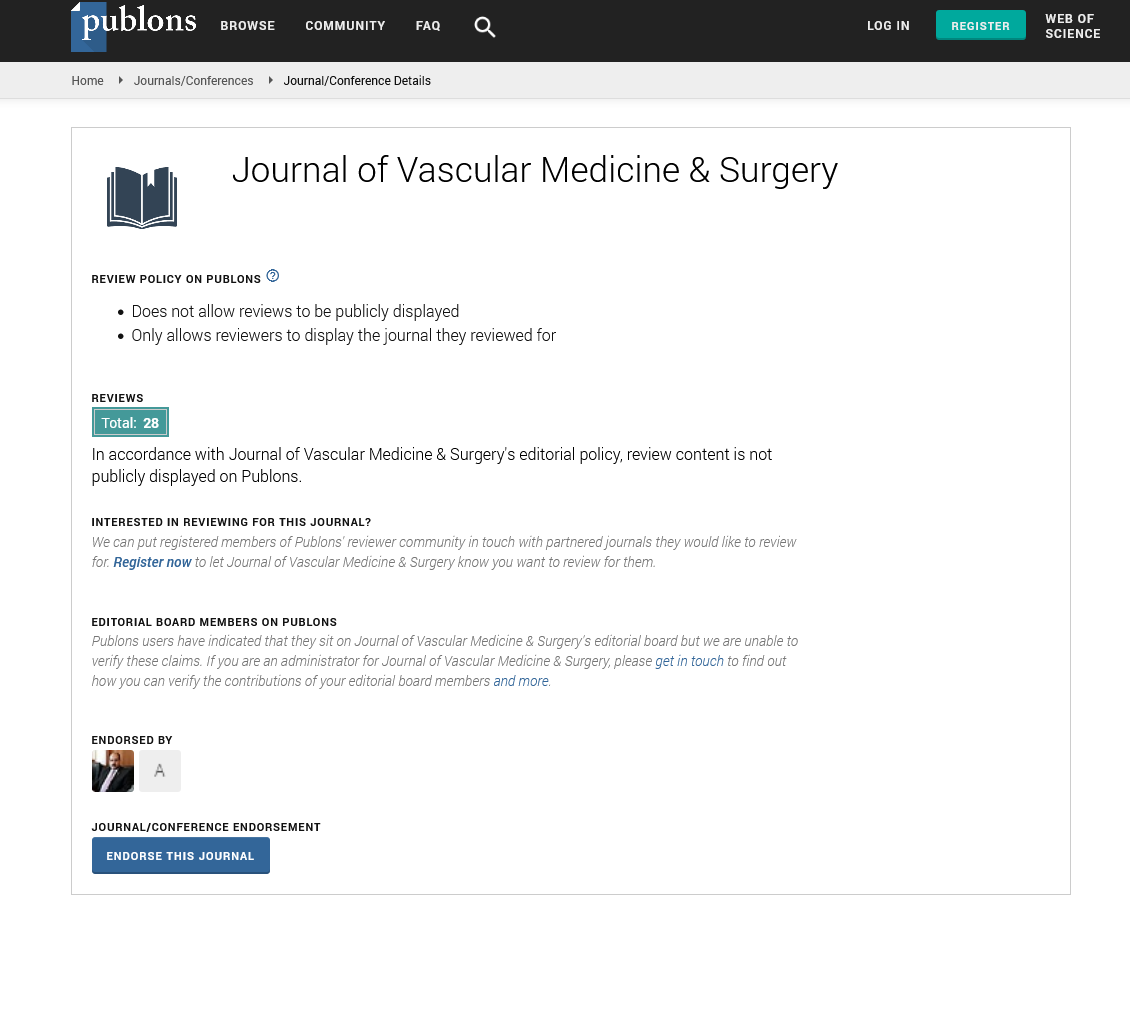Indexed In
- Open J Gate
- Academic Keys
- RefSeek
- Hamdard University
- EBSCO A-Z
- OCLC- WorldCat
- Publons
- Euro Pub
- Google Scholar
- SHERPA ROMEO
Useful Links
Share This Page
Journal Flyer

Open Access Journals
- Agri and Aquaculture
- Biochemistry
- Bioinformatics & Systems Biology
- Business & Management
- Chemistry
- Clinical Sciences
- Engineering
- Food & Nutrition
- General Science
- Genetics & Molecular Biology
- Immunology & Microbiology
- Medical Sciences
- Neuroscience & Psychology
- Nursing & Health Care
- Pharmaceutical Sciences
Perspective - (2025) Volume 13, Issue 4
Venous Thromboembolism: Beyond Anticoagulation
Alexandra Moran Baird*Received: 31-Mar-2025, Manuscript No. JVMS-25-28768; Editor assigned: 02-Apr-2025, Pre QC No. JVMS-25-28768 (PQ); Reviewed: 16-Apr-2025, QC No. JVMS-25-28768; Revised: 23-Apr-2025, Manuscript No. JVMS-25-28768 (R); Published: 30-Apr-2025, DOI: 10.35248/2329-6925.25.13.595
Description
The management of Venous Thromboembolism (VTE) has undergone a remarkable transformation over the past decade, transitioning from a relatively uniform approach centered on vitamin K antagonists to a nuanced paradigm incorporating novel oral anticoagulants, advanced interventional techniques, and risk-stratified treatment algorithms. Despite these advances, VTE remains a significant cause of morbidity and mortality, affecting approximately 900,000 Americans annually and causing 100,000 deaths. As our understanding of VTE pathophysiology has evolved, so too has our appreciation for the heterogeneity of this disease process and the need for individualized therapeutic strategies.
Anticoagulation remains the cornerstone of VTE management, but the traditional one-size-fits-all approach has given way to more sophisticated decision-making. The introduction of Direct Oral Anticoagulants (DOACs) has simplified treatment while potentially improving safety profiles compared to warfarin. However, the expanding anticoagulation armamentarium necessitates careful consideration of patient-specific factors including renal function, concomitant medications, bleeding risk, cost, and adherence patterns. Furthermore, emerging evidence suggests differential efficacy among anticoagulant options for specific VTE presentations and patient populations, creating opportunities for precision medicine approaches.
Beyond anticoagulation, interventional strategies for VTE have experienced a renaissance, particularly for patients with extensive proximal Deep Vein Thrombosis (DVT) or massive/submassive Pulmonary Embolism (PE). Catheter-directed thrombolysis for iliofemoral DVT has demonstrated potential to reduce post-thrombotic syndrome compared to anticoagulation alone, though optimal patient selection remains controversial. The ATTRACT trial failed to demonstrate overall benefit in preventing post-thrombotic syndrome but suggested potential advantages in the iliofemoral DVT subgroup. Similarly, the CAVA trial showed mixed results depending on thrombus location. These findings underscore the importance of anatomic considerations and timing in intervention decisions.
Inferior Vena Cava (IVC) filter use has contracted appropriately following the PREPIC studies demonstrating increased DVT risk without mortality benefit with permanent filters. However, retrievable filters maintain a role in select scenarios, particularly when anticoagulation is temporarily contraindicated in high-risk patients. The critical importance of timely filter retrieval has been increasingly recognized, with institutional tracking systems now standard of care. Innovative designs including convertible and biodegradable filters are under investigation to address the persistent challenge of filter retrieval failures.
Cancer-associated thrombosis merits special consideration as a distinct VTE entity with unique management considerations. The traditional approach using low-molecular-weight heparin has been challenged by recent trials demonstrating non-inferiority or superiority of select DOACs in this population. However, thrombotic and bleeding risks remain elevated, necessitating careful risk assessment and monitoring. Biomarker-guided risk stratification and primary prophylaxis strategies for high-risk oncology patients represent evolving frontiers.
Perhaps most significantly, our conceptualization of VTE has shifted from an acute event requiring time-limited treatment to a chronic condition with variable recurrence risk. Extended anticoagulation decisions now incorporate sophisticated risk assessment models, D-dimer strategies, and residual vein thrombosis evaluation. The EINSTEIN CHOICE, AMPLIFY-EXT, and SURVET trials have demonstrated the potential benefit of extended or dose-reduced anticoagulation in selected patients, while the DASH, Vienna, and HERDOO2 risk scores help identify candidates for treatment cessation.
Conclusion
Additionally, recognition of VTE sequelae including postthrombotic syndrome and chronic thromboembolic pulmonary hypertension has emphasized the importance of early identification and specialized management pathways for these conditions. Compression therapy, exercise programs, and venous stenting play important roles in post-thrombotic syndrome, while pulmonary endarterectomy, balloon pulmonary angioplasty, and riociguat have transformed the management of chronic thromboembolic pulmonary hypertension. As we advance our understanding of VTE pathophysiology and management, the vascular specialist must integrate an expanding evidence base while maintaining focus on patient-centered outcomes. This requires collaborative, multidisciplinary approaches through dedicated VTE programs that coordinate diagnostic protocols, risk stratification, acute intervention, longitudinal care, and outcomes tracking.
Citation: Baird AM (2025). Venous Thromboembolism: Beyond Anticoagulation. J Vasc Surg. 13:595.
Copyright: © 2025 Baird AM. This is an open access article distributed under the terms of the Creative Commons Attribution License, which permits unrestricted use, distribution, and reproduction in any medium, provided the original author and source are credited.

